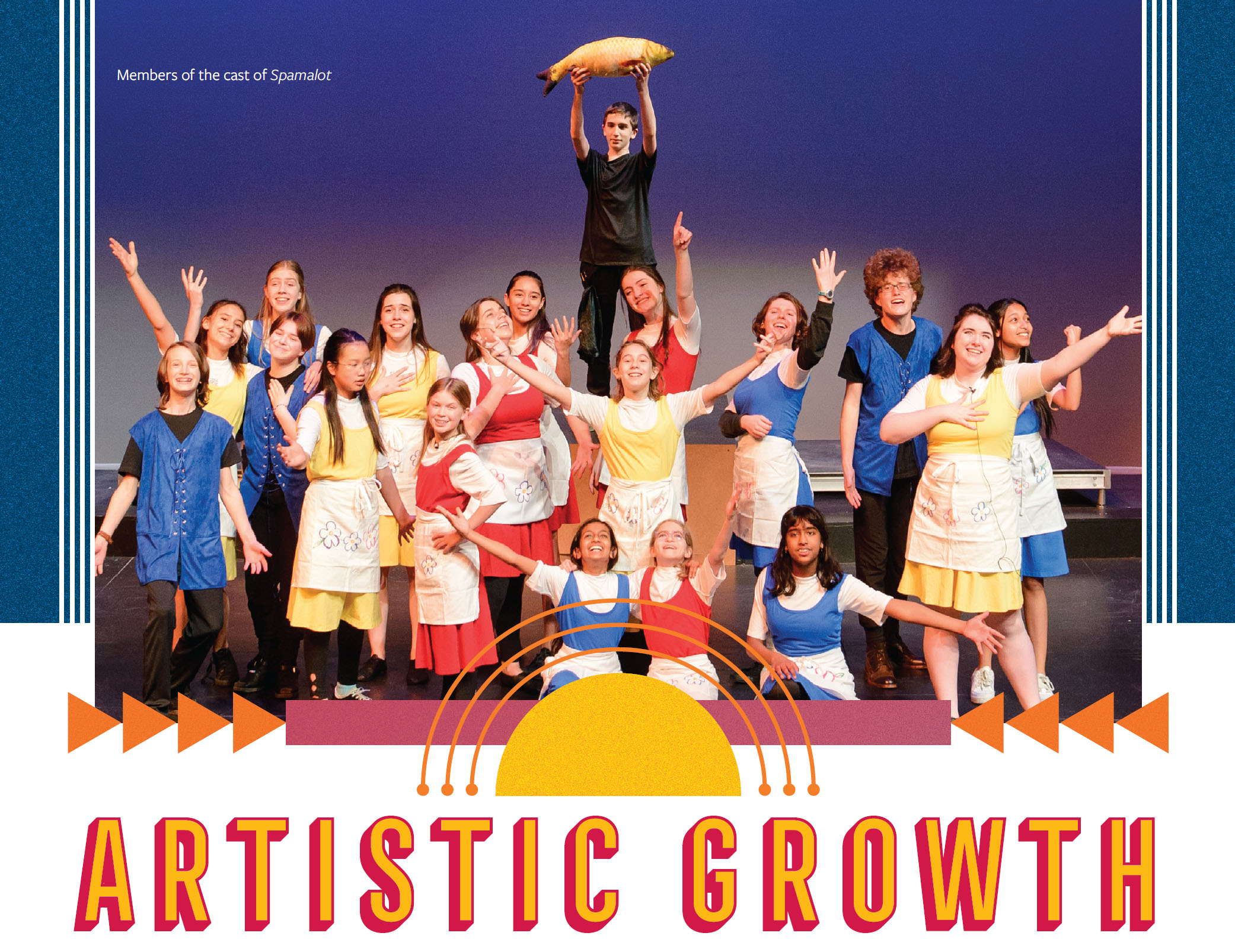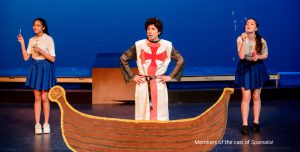
By Ginger Ellingson, Director of Fine and Performing Arts
 A REVIEW OF THE HISTORIC COURSE CATALOG reveals that in 2004 there was only one art course offered, titled “Art.” In the eighteen years since, Eastside Prep has grown in many ways, in people, buildings, resources, and experiences, and has become the thriving school we know today. This expansion has allowed the Fine and Performing Arts to thrive along with it. I have witnessed much of that growth since arriving at EPS in 2014. That year, the music classroom was still essentially a one-room schoolhouse that welcomed everyone, all skill levels and all instruments. EPS’s one-story brick buildings also still resembled its humble office-park beginnings, but those structures were misleading—inside there was more imagination and strategic vision than any unsuspecting visitor could possibly know. Similarly, despite the literal cacophony (or perhaps because of it), the Fine and Performing Arts were building relationships, taking first steps in specializing, and shaping the future of the current arts community.
A REVIEW OF THE HISTORIC COURSE CATALOG reveals that in 2004 there was only one art course offered, titled “Art.” In the eighteen years since, Eastside Prep has grown in many ways, in people, buildings, resources, and experiences, and has become the thriving school we know today. This expansion has allowed the Fine and Performing Arts to thrive along with it. I have witnessed much of that growth since arriving at EPS in 2014. That year, the music classroom was still essentially a one-room schoolhouse that welcomed everyone, all skill levels and all instruments. EPS’s one-story brick buildings also still resembled its humble office-park beginnings, but those structures were misleading—inside there was more imagination and strategic vision than any unsuspecting visitor could possibly know. Similarly, despite the literal cacophony (or perhaps because of it), the Fine and Performing Arts were building relationships, taking first steps in specializing, and shaping the future of the current arts community.
 The year 2015 witnessed an impactful step forward when the music program began to differentiate classes by skill and instrument. Introduction to Band and Introduction to Orchestra were offered for students new to their instruments, and experienced students dedicated to an advanced performance ensemble chose between Chamber Music Ensemble and Chamber Choir. Today, there is substantial diversification in course offerings, specification in content, and differentiation in skill. This upcoming school year, we will offer thirty-seven unique classes taught by nine faculty in eight specialized classrooms. Additionally, courses specialize by content area as well. The Instrumental Music Ensemble continues to welcome a wide range of skill, and content focuses on the cultural context and performance styles of popular music. In the 2022-2023 academic year, the course will be known as Rock Orchestra, with Rock Voice Studio as the vocal counterpart. Similarly, the visual art program that started out offering the one course in 2004 has expanded to eighteen trimester-length courses offered each year. Starting in 2022-2023, advanced-level visual art students will have the opportunity to refine their artistic identity in Portfolio Development. The Theatre program includes ten courses and puts on three after-school productions each year: a Middle School play, an Upper School play, and an all-school musical.
The year 2015 witnessed an impactful step forward when the music program began to differentiate classes by skill and instrument. Introduction to Band and Introduction to Orchestra were offered for students new to their instruments, and experienced students dedicated to an advanced performance ensemble chose between Chamber Music Ensemble and Chamber Choir. Today, there is substantial diversification in course offerings, specification in content, and differentiation in skill. This upcoming school year, we will offer thirty-seven unique classes taught by nine faculty in eight specialized classrooms. Additionally, courses specialize by content area as well. The Instrumental Music Ensemble continues to welcome a wide range of skill, and content focuses on the cultural context and performance styles of popular music. In the 2022-2023 academic year, the course will be known as Rock Orchestra, with Rock Voice Studio as the vocal counterpart. Similarly, the visual art program that started out offering the one course in 2004 has expanded to eighteen trimester-length courses offered each year. Starting in 2022-2023, advanced-level visual art students will have the opportunity to refine their artistic identity in Portfolio Development. The Theatre program includes ten courses and puts on three after-school productions each year: a Middle School play, an Upper School play, and an all-school musical.
A program-wide effort to inspire and prepare 21st century learners has also resulted in a digital studies curriculum. In addition to Digital Storytelling (’06), Filmmaking (’06), Graphic Design (’07), Photography (’16), and Illustration (’21), the newest course will be Digital Music Studio (’22). Specialized instructional spaces aid in these efforts: the Media Studio in TALI provides students with access to state-of-the-art film and music production software, a green screen, portrait drops, professional cameras, and a lighting grid. Additionally, the opening of TALI Hall included two art studios, two music studios, a theatre, dressing room, and set shop.
Even with substantial expansion, at the heart of arts education remains the artistic process and a commitment to the student experience. As the Fine & Performing Arts program has diversified, we continue to make connections between the curriculums and the student experience, ensuring that each class relates across the artistic programs and the larger EPS curriculum. To facilitate these goals and to develop a shared language among our several disciplines, the Fine and Performing Arts program has adopted the National Standard for Arts Education as our shared framework of articulating the artistic process. Much like the mission statement that rings daily through the hallways of EPS, the shared language of the arts is similarly simple and powerful: Create, Present, Respond, Connect. While these processes may look very different in Amis Balcomb’s Magic of Art class compared to Luke Stromberg’s Rock Voice Studio, the value of the shared language lies in the connection across experiences. As we have grown, specialized, and moved physical spaces, this language has given the Fine & Performing Arts one identity. And although our courses are now widely differentiated by skill, content area, and tools, they remain connected through the same artistic process that was also present in 2004 when there was a single class offered called “Art.”
The joy of being known and being connected is in sharing. In the spring of 2022, the Fine & Performing Arts hosted the first-ever Arts Fest. Sounds of music and chatter filled the TALI Gallery and Atrium as guests viewed artwork from visual art courses throughout the year and gathered before and after music concerts. This spring also saw the Directing Projects hosted in-person for the first time since 2019, celebrating Upper School students who directed their own short plays. And in April, the arts launched a new lunchtime music series called Sound Bites, featuring soloists and small groups who shared their work with passersby during the lunch period. Many thanks to those students willing to kick off this new project: Arjun (’24) on piano, Olivia (’24) singing soprano, the Synchronized Singing club (Toby, Skye, and Ansuya—all Class of 2025), Jug Band (Dr. Larner-Lewis, Oliver Dettweiler (’24), Sam Tippett (’24), and the Chamber Choir. As the Fine & Performing Arts look to the future, we want the EPS community near and far to share in the joy that art students create daily in our studios and on our stages.

